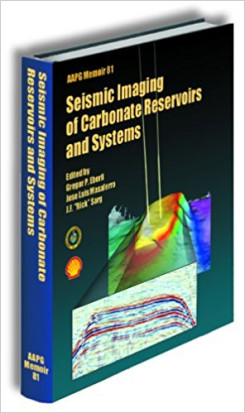Seismic Imaging of Carbonate Reservoirs and Systems
Recent advances in seismic acquisition, processing and visualization techniques image carbonate strata with unprecedented resolution. This volume documents the current state of the art in seismic imaging and interpreting of carbonate systems and captures the dynamics of the carbonate system on a large exploration scale and on a small reservoir scale.
The book emphasizes the newest approaches in seismic visualization, seismic sedimentology and stratigraphy, seismic attribute analysis and their application for building improved 3-D reservoir models. Among the topics covered are the delineation of the complex histories of carbonate platform sequences from seismic data, the relationships between geometries and forming processes, the imaging of faults for improved mapping of potential fluid migration pathways, and use of seismic attributes for the extraction of rock properties in the sedimentary bodies.
The book illustrates the power of integrating seismic and geological data to better predict of the architecture and heterogeneities in carbonate depositional systems. As such the book will be a useful reference for both geologists and geophysicists.
- Genre: All Books, Carbonates, Geophysics
Cast & Characters
| 11-42 | Three-dimensional seismic volume visualization of carbonate reservoirs and structures |
| 43-58 | Three-dimensional seismic attributes help define controls on reservoir development: case study from the Red River Formation, Williston Basin |
| 59-90 | Sequence-stratigraphic, petrophysical, and multicomponent seismic analysis of a shelf-margin reservoir: Sand Andres Formation (Permian), Vacuum Field, New Mexico, United States |
| 91-106 | Integrated reservoir characterization of a carbonate ramp reservoir, South Dagger Draw Field, New Mexico: seismic data are onlyu part of the story |
| 107-122 | Three-dimensional seismic imaging and reservoir modeling of an Upper Paleozoic "reefal" buildup, Reinecke Field, West Texas, United States |
| 123-148 | Three-dimensional seismic analysis in the characterization of a giant carbonate field, onshore Abu Dhabi, United Arab Emirates |
| 149-168 | An integrated reservoir study of the Liuhua 11-1 Field using a high-resolution three-dimensional seismic data set |
| 169-184 | Quantitative seismic reservoir characterization of an Oligocene-Miocene carbonate buildup: Malampaya Field, Philippines |
| 185-206 | Stratal geometries and patterns of platform carbonates: the Cretaceous of Oman |
| 207-250 | Carbonate platform to basin transitions on seismic data and in outcrops: Great Bahama Bank and the Maiella platform margin, Italy |
| 251-266 | Outcrop and seismic exrepssions of coral reefs, carbonate platforms and adjacent deposits in the Tertiary of the Salalah Basin, South Oman |
| 267-290 | Seismic expressions of prograding carbonate bank margins: Middle Miocene, Maldives, Indian Ocean |
| 291-308 | A Neogene carbonate platform, slope and shelf edifice shaped by sea level and ocean currents, Marion Plateau (Northeast Australia) |
| 309-328 | Seismic stratigraphic evolution of the Miocene-Pliocene Segitiga platform, East Natuna Sea, Indonesia: the origin, growth and demise of an isolated carbonate platform |
| 329-350 | Growth architecture, faulting and karstification of a Middle Miocene carbonate platform, Locnia Province, offshore Sarawak, Malaysia |
| 351-365 | Seismic expression of the boundaries of a Miocene carbonate platform, Sarawak, Malaysia |

